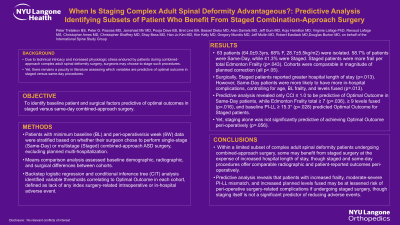When is Staging the Better Choice?: Identifying Subsets of Adult Spinal Deformity Patient Who Benefit From Staged Surgery
When Is Staging the Better Choice?: Identifying Subsets of Adult Spinal Deformity Patient Who Benefit from Staged Surgery
Friday, April 21, 2023


Jamshaid M. Mir, MD
Research Fellow
NYU Langone Medical Center
Paterson, NJ, US
ePoster Presenter(s)
Introduction: There remains a paucity in the literature assessing which patient and surgical variables are predictive of optimal outcome in staged versus same-day procedures, as well as indicators to determine when staging ASD surgery is appropriate.
Methods: ASD patients were stratified based on whether their surgeon chose to perform single-stage or multistage surgery. Means comparison assessed differences between 4 groups: Staged-Optimal/Suboptimal (Staged-O/S) and Same Day-Optimal (SameDay-O/S). Logistic regression and CIT identified thresholds correlating to optimal outcome, defined as >2 of the following: 1) no 90-day reoperation or revision 2) achievement of MCID in ODI 3) no mechanical complication, and 4) no major intraoperative complications.
Results: 902 patients (63.0yrs, 64% F) were isolated. For SameDay-O patients, regression analysis revealed significant factors to be: age < 76.53 years, being classified as Not Frail by mASD-FI, BMI < 30.22 kg/m2, no history of drug/alcohol abuse, no history of renal disease, total levels fused < 9, and no planned VCR or corpectomy (model p < .006). In contrast, for Staged-O patients, significant factors were: age < 83.53 years, being classified as Not Frail or Frail by mASD-FI, BMI < 37.22 kg/m2, history of neurological deficits, history of arthritis, total levels fused < 11, and a UIV below C7 (model p=.002). For SameDay-S patients, factors associated with failure of meeting optimal outcomes were: age > 77.40 years, being classified as Frail or Severely Frail by mASD-FI, and blood loss of > 2010.72 mL. For Staged-S patients, however, only age > 85.60 years and operative time (total) > 540 min was associated with poor outcomes overall (all p < .05).
Conclusion : Though the majority of patients may be equally likely to see optimal results post-operatively regardless of staged/not-staged status, older patients with greater degrees of comorbidities and increased planned surgical invasiveness demonstrate superior outcomes with decreased risk of complications when undergoing staged procedures.
Methods: ASD patients were stratified based on whether their surgeon chose to perform single-stage or multistage surgery. Means comparison assessed differences between 4 groups: Staged-Optimal/Suboptimal (Staged-O/S) and Same Day-Optimal (SameDay-O/S). Logistic regression and CIT identified thresholds correlating to optimal outcome, defined as >2 of the following: 1) no 90-day reoperation or revision 2) achievement of MCID in ODI 3) no mechanical complication, and 4) no major intraoperative complications.
Results: 902 patients (63.0yrs, 64% F) were isolated. For SameDay-O patients, regression analysis revealed significant factors to be: age < 76.53 years, being classified as Not Frail by mASD-FI, BMI < 30.22 kg/m2, no history of drug/alcohol abuse, no history of renal disease, total levels fused < 9, and no planned VCR or corpectomy (model p < .006). In contrast, for Staged-O patients, significant factors were: age < 83.53 years, being classified as Not Frail or Frail by mASD-FI, BMI < 37.22 kg/m2, history of neurological deficits, history of arthritis, total levels fused < 11, and a UIV below C7 (model p=.002). For SameDay-S patients, factors associated with failure of meeting optimal outcomes were: age > 77.40 years, being classified as Frail or Severely Frail by mASD-FI, and blood loss of > 2010.72 mL. For Staged-S patients, however, only age > 85.60 years and operative time (total) > 540 min was associated with poor outcomes overall (all p < .05).
Conclusion : Though the majority of patients may be equally likely to see optimal results post-operatively regardless of staged/not-staged status, older patients with greater degrees of comorbidities and increased planned surgical invasiveness demonstrate superior outcomes with decreased risk of complications when undergoing staged procedures.
